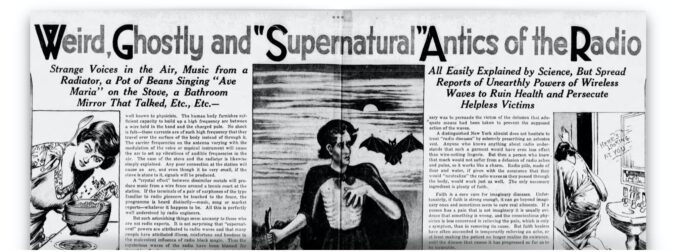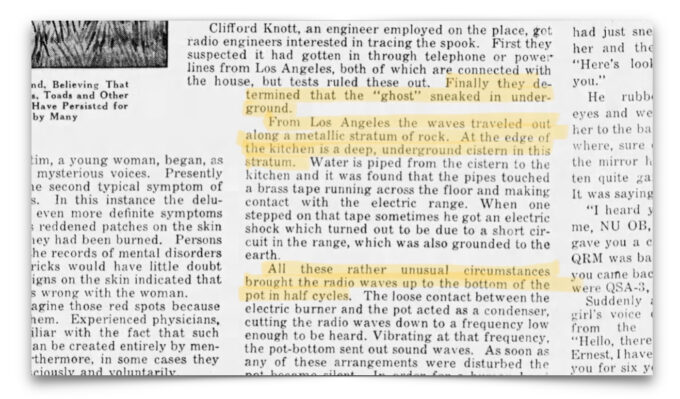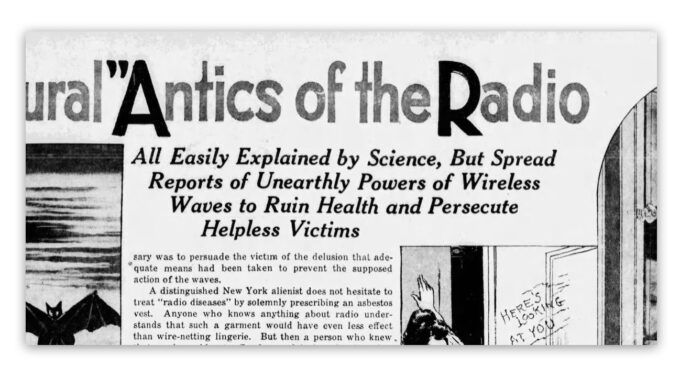This was originally published on Pessimists Archive.
Did the rise of 19th century technologies – such as radio – lead to an increase in reports of the supernatural?
That’s the question Atlantic writer Derek Thompson asked on Twitter this week and it brought to mind a 1931 piece from the archive titled: Weird, Ghostly and “Supernatural” Antics of the Radio, the piece explored reports of supernatural phenomena prompted by the rise of radio.

We had a voice actor perform the 1931 article.
The Piece: A Breakdown

The piece consisted of a richly illustrated two-page spread about fictitious reports of ghostly sounds, prompted by the rise of radio broadcasting. A singing; pot, mirror, bed and radiator were all brought to life via illustration, their owners curiously inspecting the seemingly possessed objects.

The anecdotes of strange happenings were numerous, described in vivd and poetic detail: “An old-fashioned iron stove in the basement of a nearby schoolhouse furnishes entertainment to the children during recess… …the children find it a reliable substitute for a radio receiving set.“

While the paper did admit some reports were paranoid, imagined or psychosomatic delusions, it also took many of them seriously and presented a scientific explanation for what could be happening. It lent sympathy to those giving testimony because – thanks to radio – “very real voices are heard and other seemingly “supernatural” things are happening all the time.” It noted how radio engineers had determined a ‘radio ghost’ in Los Angeles had sneaked into a house underground via “a metallic stratum of rock.”

To engineers like them these were not surprising phenomena it said, however:
Such astonishing things seem uncanny to those who are not radio experts. It is not surprising that “supernatural” powers are attributed to radio waves and that many people have attributed illness, misfortunes and hoodoos to the malevolent influence of radio black magic.
It noted an important and often forgotten part of radio history: it was an incredibly strange and abstract technology – one that felt like something described in religious texts as ominous and omnipresent. This it said, was why radio had been blamed for “droughts, floods, earthquakes, heat, cold, headaches, stomachaches, the withering of vegetation, and even death of animals and human beings.” It also noted that another new technology, X-rays, which could penetrate walls and have ill effects on health, helped stoke fears about radio too.
Doctors it said were humoring patients with imaginary radio ailments and prescribing harmless placebos – like wire net underwear, and not so harmless, asbestos vests. The Chronicle had a question for these doctors however: “How can the medical fraternity be so cocksure that all these radio diseases are imaginary when they cannot deny the existence of fully as strange “radio ghosts”?

In reality spate of reports weren’t ghosts or a strange new quirk of the radio age – metal objects couldn’t accidentally pickup radio broadcasts. The article acknowledged the radio panic, its imaginary ailments and the “Fakers who are always quick to seize upon popular delusions are doing business here and there, “correcting” these mysterious and hostile forces”, however – in a case of olden day bothsidesism – it failed to sufficiently condemn the technophobic panic and played a roll in lending credence to it by trying to explain some of it through a science lens.
To the publications credit it did end with a powerful and important retort to those fearing radio waves then (and now): “Radio waves are not a new thing, created by man; the only novelty about the waves is that man has regulated them in such a way as to use them to carry words, music and other signals.”
